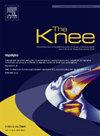徒手技术双节段膝关节变位截骨术26例单中心回顾性分析,矫正准确率高,并发症发生率低
IF 2
4区 医学
Q3 ORTHOPEDICS
引用次数: 0
摘要
背景:外翻膝关节错位合并孤立性外侧室骨关节炎(OA)对骨科医生来说是一个具有挑战性的疾病。在年轻活跃的患者中,重新对准截骨是一种很有吸引力的解决方案,可以处理当前的问题,并为未来的关节置换奠定更中性的对准。然而,对于实质性或双局部(股骨和胫骨)畸形,应考虑双水平膝关节截骨术,以保持关节线斜度,避免继发性关节畸形。方法对1170例膝关节截骨手术的单中心数据库进行回顾性分析。本研究包括26例双焦点(股骨和胫骨)外翻错位和孤立的外侧骨室骨关节炎患者,他们接受了双水平截骨矫正(胫骨高位截骨(HTO)和股骨远端截骨(DFO))。术前和术后连续记录多个prom。这包括膝关节损伤和骨关节炎结局指数评分、牛津膝关节评分、牛津膝关节评分-活动和参与问卷、西安大略和麦克马斯特大学评分、健康和疼痛视觉模拟量表以及EQ5D。EQ-5D代表EuroQol 5维;它是衡量与健康有关的生活质量(HRQoL)的标准化工具。术前和术后记录所有下肢直线指数。记录截骨翻修、转关节置换术、并发症和10年生存率。结果26例变异双节段截骨术患者,平均随访10.7±3.5年。其中男性42.3%,女性57.7%,平均年龄45.5±10.9岁,平均BMI为30.9±5.7 kg/m2。HTO和DFO的平均计划校正角度分别为7.4±2.7°和7.3±1.9°。术后平均胫股机械角度从12.5±4.4°外翻改善至- 1.5±2.6°外翻,平均MPTA从术前93.8±3.6°改善至术后87.3±2.6°,平均Mikulicz点从105.7±20.6%改善至39.9±15.5% (p值均为<;0.001)。mTFA、mLDFA和MPTA的校正精度分别为1.1±1.3°、1±2.7°和0.7±2.8°。Mikulicz的校正精度为5±15.6%。所有prom在所有时间点均显著改善,其中在随访24个月时改善最为显著(所有p值<;0.001)。截骨翻修率为3.8%。术后平均4.9±2.3年,全膝关节置换术的总成功率为15.4%。并发症发生率为7.6%。10年生存率为86.5%。结论变位双节段膝关节截骨术治疗膝关节外翻伴严重股骨、胫骨双焦点畸形,可改善临床疗效和影像学参数。徒手变异DLO具有较高的矫正精度,并发症发生率低,10年生存率为86.5%。本文章由计算机程序翻译,如有差异,请以英文原文为准。
High correction accuracy and low complication rate of double-level knee varization osteotomy using the free-hand technique: A single-centre retrospective analysis of 26 cases
Background
Valgus knee malalignment with isolated lateral compartment osteoarthritis (OA) represents a challenging condition to the orthopaedic surgeon. In the young active patient, realignment osteotomy represents an appealing solution to manage the presented problem and lay a more neutral alignment for future conversion arthroplasty. Nevertheless, in substantial or bifocal (femur and tibia) deformities, double-level knee osteotomy should be considered to maintain joint line obliquity and avoid introducing secondary joint deformities.
Methods
A retrospective review of a prospectively maintained single-centre database of 1170 knee osteotomies was undertaken. Twenty-six patients with bifocal (femur and tibia) valgus malalignment and isolated lateral compartment osteoarthritis who had double-level osteotomy corrections (high tibial osteotomy (HTO) and distal femoral osteotomy (DFO)) were included. Multiple PROMs were recorded preoperatively and serially postoperatively. This included the Knee Injury and Osteoarthritis Outcome index scores, the Oxford knee score, Oxford Knee Score – Activity and Participation Questionnaire, the Western Ontario and McMaster University Scores, the Visual Analogue Scale for health and pain, and the EQ5D. EQ-5D stands for EuroQol 5-Dimension; it is a standardized instrument for measuring health-related quality of life (HRQoL). All lower limb alignment indices were recorded pre-and postoperatively. The rates of osteotomy revision, conversion to arthroplasty, complications, and 10-year survivorship were recorded.
Results
A total of 26 varization double-level osteotomy cases were followed up to a mean of 10.7 ± 3.5 years. This comprised 42.3 % males and 57.7 % females, with a mean age of 45.5 ± 10.9 years and a mean BMI of 30.9 ± 5.7 kg/m2. The mean planned correction angles for HTO and DFO were 7.4 ± 2.7° and 7.3 ± 1.9°, respectively. Postoperatively, the mean mechanical tibiofemoral angle improved from 12.5 ± 4.4° valgus to – 1.5 ± 2.6° varus, the mean MPTA improved from preoperative 93.8 ± 3.6° to postoperative 87.3 ± 2.6°, and the mean Mikulicz point improved from 105.7 ± 20.6 % to 39.9 ± 15.5 % (all P-values < 0.001). A high correction accuracy was reported for the mTFA, mLDFA and MPTA of 1.1 ± 1.3°, 1 ± 2.7°, and 0.7 ± 2.8°, respectively. The correction accuracy for the Mikulicz was 5 ± 15.6 %. All PROMs significantly improved at all time points with the most significant improvement noted at 24 months follow up (all P-values < 0.001). The rate of osteotomy revision was 3.8 %. The overall rate of total knee arthroplasty conversion was 15.4 % at an average of 4.9 ± 2.3 years postoperatively. The complication rate was 7.6 %. The 10-year survivorship was 86.5 %.
Conclusion
Varization double-level knee osteotomies for valgus knees, with severe malalignment with bifocal femoral and tibial deformities, improves clinical outcomes and radiological alignment parameters. Free-hand varization DLO demonstrated high correction accuracy with a low complication rate of 7.6 % and survivorship of 86.5 % at 10 years.
求助全文
通过发布文献求助,成功后即可免费获取论文全文。
去求助
来源期刊

Knee
医学-外科
CiteScore
3.80
自引率
5.30%
发文量
171
审稿时长
6 months
期刊介绍:
The Knee is an international journal publishing studies on the clinical treatment and fundamental biomechanical characteristics of this joint. The aim of the journal is to provide a vehicle relevant to surgeons, biomedical engineers, imaging specialists, materials scientists, rehabilitation personnel and all those with an interest in the knee.
The topics covered include, but are not limited to:
• Anatomy, physiology, morphology and biochemistry;
• Biomechanical studies;
• Advances in the development of prosthetic, orthotic and augmentation devices;
• Imaging and diagnostic techniques;
• Pathology;
• Trauma;
• Surgery;
• Rehabilitation.
 求助内容:
求助内容: 应助结果提醒方式:
应助结果提醒方式:


